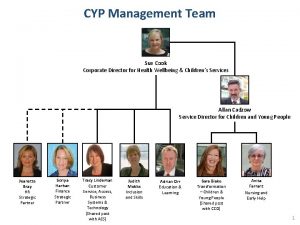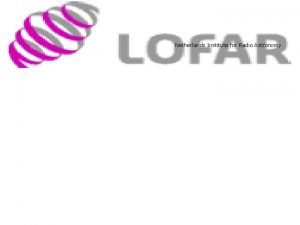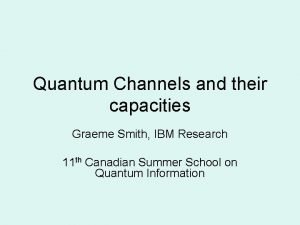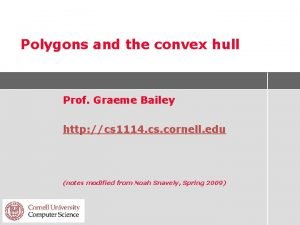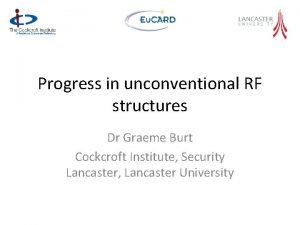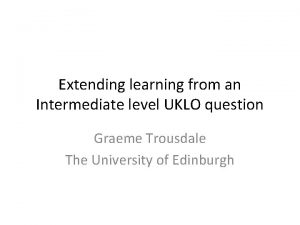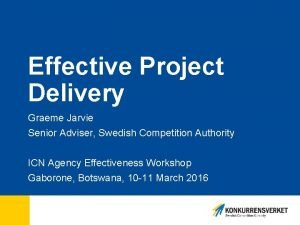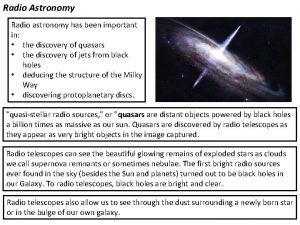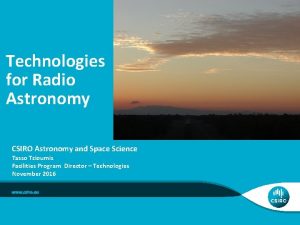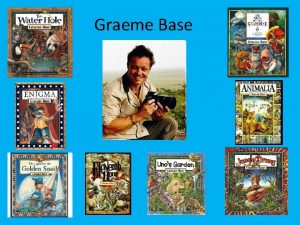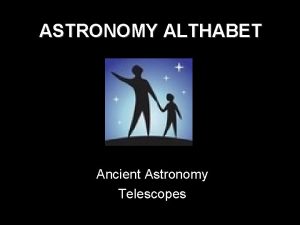Technologies for Radio Astronomy Graeme Carrad Assistant Director


















- Slides: 18

Technologies for Radio Astronomy Graeme Carrad | Assistant Director - Engineering Mark Bowen | Group Leader – Front End Technologies JULY 2012 CSIRO ASTRONOMY AND SPACE SCIENCE

Outline Technologies for Radio Astronomy • CABB • ATCA C/X Upgrade • FAST Parkes – Future Receiver Systems Technologies | Graeme Carrad| Page 2

Compact Array Broadband Backend Status • 64 MHz zoom mode with all 16 zooms available has an estimated delivery date this winter season. • Late but can only apologise. • The complexity demands more experienced resources and they are not available. It is estimated at 90% complete with the remaining work being to output the data in a suitable format to cope with the data rate at 64 times the 1 MHz rate. Not all the data can come out at once. • Tim Bateman, Bob Sault and Warwick Wilson tackling, successfully, a long list of operational issues highlighted by Jamie Stevens and Robin Wark. • Last ATUC meeting it was asked, do we stop zoom development after 64 MHz delivery and fix CABB’s bugs first? – The feeling is that much will have been accomplished in bug fixes. Technologies | Graeme Carrad| Page 3

ATCA C/X Upgrade Status • Australian Astronomy Ltd. funded program - upgrade funding continues until June 2013. • Prototype receiver installed on ATCA during Nov 2011. • Development of a production LNA is complete and the manufacture of LNA hardware is underway. • The manufacture of hardware and components for the production receivers is well underway. • The first two receivers (production) are currently in the CASS Marsfield laboratories undergoing modification. • Two production receivers will be installed on the ATCA during Aug – Sep 2012. Parkes receiver options| Graeme Carrad| Page 4

ATCA C/X Upgrade 4. 0 – 12. 25 GHz Feed Prototype • Existing C/X feed horn does not work above 10. 8 GHz. • Feed investigations carried out by CSIRO ICT Centre and BAE Systems. • Consultation with user community identified limited interest in extending operation from 10. 8 GHz – 12. 0 GHz. • A prototype 4. 0 – 12. 25 GHz feed horn will be delivered by BAE Systems. • The feed will be tested on the ICT Centre antenna range then installed on the ATCA for evaluation. • An estimate of the cost to outfit the ATCA including new feeds and CABB signal path hardware modifications will be made.

FAST Multi-beam Receiver - Feasibility Study Background • 19 beams at 1. 05 GHz – 1. 45 GHz. • CSIRO ICT Centre designing feed and OMT, CASS studying LNA and cryostat. • JBCA developing alternative designs. Status • ICTC feed electromagnetic design complete. • CASS LNA and cryostat design underway. Parkes receiver options| Graeme Carrad| Page 6

Parkes Receivers

What are we considering? First stage in developing a longer term plan Wideband Receiver 700 MHz to 4 GHz 4 – 16 GHz (18 GHz? ) (20 GHz? )(24 GHz? ) PAF Frequency coverage comparable to ASKAP PAF? 20 - 25 GHz Multibeam Receiver Does this development make the most from the feasibility studies? Should we build another multibeam receiver? Parkes receiver options| Graeme Carrad| Page 8

What would a PAF provide? ASKAP Mk. II system is already achieving rather competitive Tsys/η ≈ 55 K on 12 m, likely between about 800 – 1600 MHz. PAFs provide much better spectral baseline performance than SPFs. New science possibilities with 36 beams: – Pulsar surveys – Deep HI for “Intensity Mapping” and “HI Cosmic Web”

What do we know? Wideband Receivers MPIf. R are developing a 600 MHz - 3 GHz receiver with uncooled feed/OMT. Target of Tsys ≤ 50 K Our own investigations indicate the wideband elements are non trivial/difficult to design despite knowledge of the MPIf. R program. Cooling the feed/OMT is desirable but presents a challenge. The wide bandwidth is likely to require a compromise - lesser performance than current receivers over some or all of the band. This development may complement plans for future receiver rationalisation. At this stage we do not know enough to advise on likely performance. Parkes receiver options| Graeme Carrad| | Page 10

What do we know? PAF Experience in modelling, fabricating and the performance (ASKAP). BETA PAF exists – Mk. 1. ADE PAF is under development but the initial results (5 x 4) look promising – Mk. 2. Current BETA PAF on Parkes is likely to be an ‘experiment’. This might be a quick way to explore PAFs on a large dish but will carry an operational overhead. Additional resources required from proponents. CASS is more likely to lead a program for a PAF with the performance of the current 5 x 4 (Full Bandwidth). Modularity is necessary for future upgrades. (Cryo PAF? ) External support for a Parkes PAF has been mooted. (SIEF? ) Parkes receiver options| Graeme Carrad| | Page 11

What do we know? 20 – 25 GHz Multibeam Receiver We have the experience in this frequency range. MMIC fabrication is almost certainly required together with a significant conversion and frequency conversion scheme. Likely high cost and longer term program to deliver. The Parkes dish performance is poorer at these frequencies compared with the lower frequencies. The majority of observing at Parkes (~70%) is done at lower frequencies. Parkes receiver options| Graeme Carrad| | Page 12

Approaches Wideband Receivers Conduct a feasibilty study to determine the design, performance and compromises as well as addressing some of the challenges in cooling. This study is likely to take 6 months (best estimate). Backend considerations aligned with Parkes needs. Stay in touch with MPIf. R progress. A 4 GHz ‘up’ proof of concept to start off would be smaller and physically less demanding, provide experience and give Parkes enhanced capability. It may be more appropriate to start development at the higher frequency as one step in the path to the 700 MHz – 4 GHz receiver. Starting with a 600 MHz to 4 GHz receiver addresses the majority of the observing but if the performance falls short there is knowledge gained but no suitable receiver to replace existing ones. A successful implementation of a 700 MHz – 4 GHz also aligns with the strategy of reducing receiver changes. Parkes receiver options| Graeme Carrad| | Page 13

Approaches PAF Conduct a feasibility study to determine scope of work required to fit a PAF to Parkes. How good does the PAF need to be? Does it need to be a replacement for the centre beam of the L band multibeam? If that can’t be achieved with current designs then that implies more development. This will set the timeline for implementation. Can a new chequerboard and amplifiers coming from ADE developments be adapted for a BETA PAF? Upgrade path for BETA and ADE PAF systems. Have a design team start exploring the incorporation of BETA and ADE PAF structures into Parkes focus cabin – mechanical and heat load considerations. Backend considerations aligned with Parkes needs. Parkes receiver options| Graeme Carrad| | Page 14

Considerations Calibration A parallel program to ensure a calibration scheme is developed along with both wideband receiver and PAF. Single dish as opposed to array for PAF. RFI Future developments in communications threaten low frequency band integrity. Do we program mitigation in, or abandon specific frequency bands? The backend complexity/cost might be defined by the need cross correlation or other mitigation techniques. Resources There is likely to be sufficient effort available to study the feasibility of two developments in parallel i. e Wideband receivers and PAF. Parkes receiver options| Graeme Carrad| | Page 15

Timelines Nice to have studies done for the next ATUC meeting (Nov) but that seems too soon. We will report on progress of the studies then. The June 2013 meeting might be too far away to seek advice on the outcomes of the studies so an out of session gathering might be considered? Parkes receiver options| Graeme Carrad| | Page 16

Priorities Parkes Are there other options? Is the high frequency multibeam the lower priority of the three considerations? We are likely to investigate both, but if there was a preference for investigating wideband receiver or PAF which would it be? We feel our wideband approach is less risky than the ‘all eggs in one basket’ consideration of the lower frequency receiver only. Compact Array Future ATUC meeting - The case for going to 12. 2 GHz on the ATCA. Parkes receiver options| Graeme Carrad| | Page 17

Thank you CSIRO Astronomy and Space Science Graeme Carrad Assistant Director - Engineering t +61 2 9372 4305 e Graeme. Carrad@csiro. au w www. csiro. au/lorem CSIRO ASTRONOMY AND SPACE SCIENCE CSIRO Astronomy and Space Science Mark Bowen Group Leader – Front End Technologies t +61 2 9372 4356 e Mark. Bowen@csiro. au w www. csiro. au/lorem
 Learning astronomy by doing astronomy activity 1 answers
Learning astronomy by doing astronomy activity 1 answers Learning astronomy by doing astronomy activity 1 answers
Learning astronomy by doing astronomy activity 1 answers Learning astronomy by doing astronomy activity 1 answers
Learning astronomy by doing astronomy activity 1 answers Cyp assistant director
Cyp assistant director Assistant director vicky
Assistant director vicky Astronmo
Astronmo Radio astronomy lectures
Radio astronomy lectures Graeme smith quantum
Graeme smith quantum Graeme malcolm
Graeme malcolm Graeme bailey
Graeme bailey Graeme burt
Graeme burt Graeme chamberlin
Graeme chamberlin Graeme stephens altocumulus
Graeme stephens altocumulus Graeme trousdale
Graeme trousdale Graeme stephens altocumulus
Graeme stephens altocumulus Graeme logan scottish government
Graeme logan scottish government Graeme beale
Graeme beale Graeme jarvie
Graeme jarvie Awin radio
Awin radio



